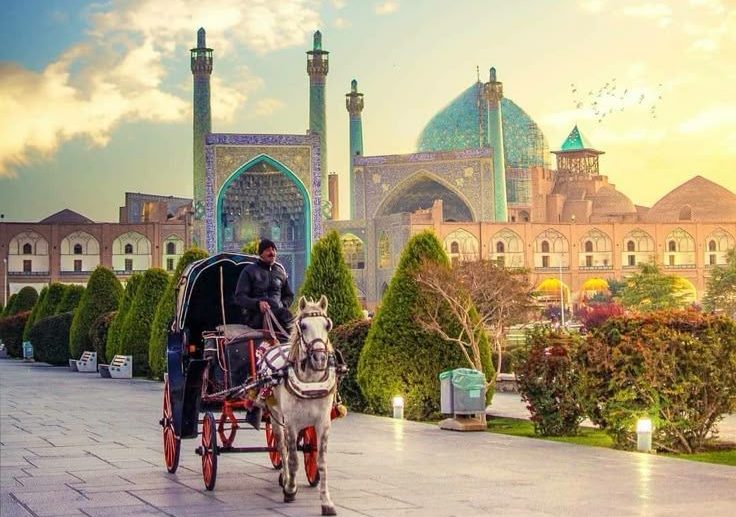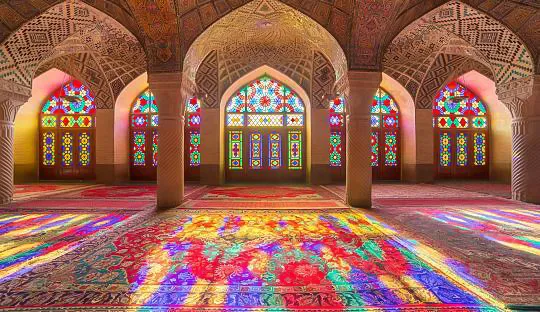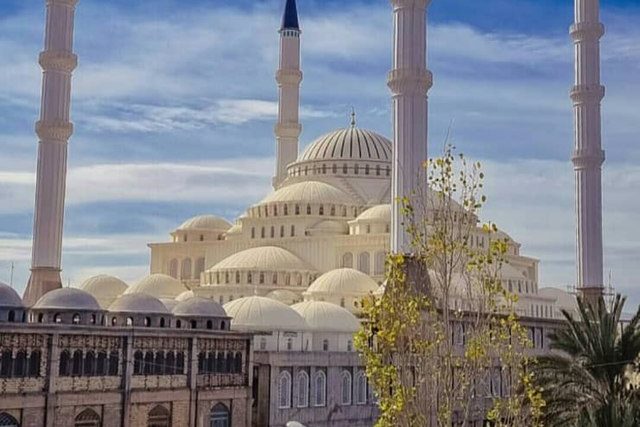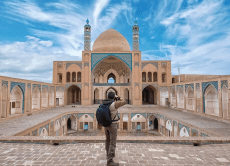Top 10 Religious Sites in Iran to Visit (2025 Guide)

Looking to explore the top 10 religious sites in Iran? This 2025 guide highlights the country’s most stunning mosques and sacred shrines, blending breathtaking architecture with deep cultural heritage. From the intricate tiles of Isfahan to the spiritual aura of Mashhad, Iran offers a unique journey for travelers and history enthusiasts alike. Let’s dive into the must-visit destinations that make Iran a gem for religious and cultural tourism
1.Vakil Mosque, Shiraz

Shiraz, a gem among Iran’s cultural hubs, is home to one of the top religious sites in Iran: the Vakil Mosque. Built during the Zand dynasty under Karim Khan’s rule in the 18th century, this mosque reflects Persian artistry and architectural brilliance. Whether you’re a history enthusiast or a traveler seeking spiritual beauty, the Vakil Mosque in Shiraz offers an experience that lingers in memory. With Kental Iran Travel, explore this iconic site and uncover its rich heritage.
History of Vakil Mosque
The Vakil Mosque was commissioned by Karim Khan Zand between 1751 and 1773, during a time when Shiraz flourished as Iran’s capital. Designed as part of a larger complex that included a bazaar and bathhouse, this mosque served both religious and communal purposes. Its historical significance and stunning design make it a standout among the top religious sites in Iran, drawing visitors eager to step back into the Zand era.
Why Visit Vakil Mosque?
What sets the Vakil Mosque apart? Here’s why it’s a must-see:
- Unique Architecture: The mosque features a grand prayer hall with 48 intricately carved columns, a hallmark of Persian design.
- Artistic Details: Admire the colorful tilings, Nastaliq and Thuluth calligraphy, and detailed inscriptions that adorn its walls.
- Accessible Location: Conveniently located near Shiraz’s bazaar, it’s easy to reach via public transportation or a short walk.
- Cultural Vibe: As one of the top religious sites in Iran, it offers a glimpse into Shiraz’s role as a historical and spiritual center.
For an enhanced visit, join a guided tour with Kental Iran Travel to fully appreciate its story and craftsmanship
2.Nasir al-Mulk Mosque, Shiraz

Nestled in the heart of Shiraz, the Nasir al-Mulk Mosque shines as one of the top religious sites in Iran. Built during the Qajar era in the late 19th century, this mosque is a masterpiece of Iranian-Islamic architecture, famous for its mesmerizing colored glass and innovative tile work. Known as the “Pink Mosque” due to its unique pink-hued tiles, it offers visitors a breathtaking blend of spirituality and art. Join Kental Iran Travel to explore this iconic gem and witness its kaleidoscope of colors in person.
History of Nasir al-Mulk Mosque
The Nasir al-Mulk Mosque was commissioned in 1876 by Mirza Hasan Ali Nasir al-Mulk, a prominent Qajar nobleman, and completed in 1888. Alongside the mosque, he ordered the construction of a bathhouse and reservoir in Shiraz’s Ishaq Bey neighborhood, reflecting his legacy of community development. Recognized as one of the top religious sites in Iran, this mosque stands out for its historical roots and its role in advancing Persian architectural traditions during the Qajar period.
Why Visit Nasir al-Mulk Mosque?
Why does this mosque captivate travelers worldwide? Here’s what makes it special:
- Colored Glass Magic: The mosque’s nave features stunning stained-glass windows that transform sunlight into a rainbow of colors across the interior.
- Pink Tile Innovation: Its pioneering use of pink tiles—a rarity in mosque design—earns it the nickname “Pink Mosque” and a unique place in history.
- Architectural Beauty: Like the Vakil Mosque, it showcases Iranian-Islamic elements with intricate details and symmetry.
- Photo-Worthy Moments: Visit in the early morning when light streams through the glass, making it a paradise for photographers.
As one of the top religious sites in Iran, the Nasir al-Mulk Mosque promises an unforgettable experience for anyone drawn to art, culture, or spirituality
3.Shah Mosque, Mashhad

Known as the “Seventy-Two Tan Mosque,” the Shah Mosque in Mashhad ranks among the top religious sites in Iran. Located in the spiritual heart of the country near the Holy Shrine of Imam Reza (AS), this historical gem blends rich history with architectural charm. Originally built as a tomb for Amir Ghiyath al-Din Malik Shah, it later transformed into a mosque, earning its unique name. For travelers visiting Mashhad—Iran’s most religious city—the Shah Mosque is a must-see stop. Let Kental Iran Travel guide you through this captivating site and other wonders of Mashhad.
History of Shah Mosque
The Shah Mosque traces its origins to the 15th century during the Timurid era, when it was constructed as the tomb of Amir Ghiyath al-Din Malik Shah, a notable figure of his time. Over the centuries, its purpose shifted, and it became a mosque known for its 72-ton stone slab—a remarkable feat of engineering. Situated close to the revered Imam Reza Shrine, this site reflects Mashhad’s deep historical and spiritual legacy, securing its place among the top religious sites in Iran.
Why Visit Shah Mosque?
What makes the Shah Mosque a standout destination? Here’s why it’s worth your time:
- Historical Significance: From a royal tomb to a mosque, its evolution tells a fascinating story of Mashhad’s past.
- Unique Feature: The massive 72-ton stone slab in its structure is a rare architectural marvel, giving it the nickname “Seventy-Two Tan Mosque.”
- Proximity to the Shrine: Its location near the Imam Reza Shrine makes it an easy addition to your spiritual journey.
- Cultural Insight: As one of the top religious sites in Iran, it offers a window into the blend of faith and history in Mashhad.
Plan your visit in the early morning or late afternoon to enjoy a quieter experience, and explore it with Kental Iran Travel for deeper insights.
4.Shafei Grand Mosque, Kermanshah

In the bustling metropolis of Kermanshah, the Shafei Grand Mosque stands out as one of the top religious sites in Iran. Dating back to the Qajar era, this architectural masterpiece reflects the rich history and Islamic heritage of western Iran. Known locally as Jame Shafi’i Mosque, it draws visitors with its stunning design and proximity to Kermanshah’s other historical gems. For an immersive experience, connect with Kental Iran Travel to explore this world-famous mosque and uncover the stories behind its walls
History of Shafei Grand Mosque
The Shafei Grand Mosque was constructed during the Qajar dynasty in the 19th century, a period when Kermanshah flourished as a cultural and commercial hub. Built to serve the city’s Sunni Shafei community, it showcases the elegance of Persian-Islamic architecture from that era. Its historical significance and intricate craftsmanship cement its status as one of the top religious sites in Iran, making it a key landmark in Kermanshah’s storied past
Why Visit Shafei Grand Mosque?
What makes this mosque a must-visit destination? Here’s why it stands out:
- Architectural Marvel: The mosque’s grand arches, detailed tile work, and harmonious design exemplify Islamic artistry.
- Historical Charm: Rooted in the Qajar era, it offers a glimpse into Kermanshah’s rich heritage.
- Convenient Location: Situated near other attractions like the Kermanshah Bazaar, it’s easy to include in your itinerary.
- Cultural Significance: As one of the top religious sites in Iran, it reflects the diversity of Islamic traditions in the region.
Visit in the late afternoon to enjoy the mosque’s serene ambiance, and let Kental Iran Travel guide you through its hidden treasures.
5.Jame Mosque, Yazd

The Jame Mosque of Yazd, also known as the Grand Mosque, is a timeless treasure among the top religious sites in Iran. With over 900 years of history, this architectural marvel in the desert city of Yazd tells a story of resilience and beauty, brick by brick. Built in the Azeri-Mongolian style, it captivates historians and travelers alike with its towering minarets and intricate design. Whether you’re tracing Iran’s Islamic heritage or exploring Yazd’s UNESCO-listed old city, Kental Iran Travel can guide you through this iconic site and its surrounding wonders.
History of Jame Mosque
Dating back to the 12th century, the Jame Mosque of Yazd has witnessed nearly a millennium of change. Historical texts refer to it by various names, including Jameh Shahristan Mosque and New Jameh Mosque, reflecting its evolving identity. Some believe its foundations rest atop a pre-Islamic Zoroastrian fire temple, blending ancient Persian and Islamic legacies. Constructed primarily during the Seljuk and Ilkhanid periods, its Azeri-Mongolian style shines through in its grand portals and minarets, earning it a place among the top religious sites in Iran.
Why Visit Jame Mosque?
What makes the Jame Mosque a must-see in Yazd? Here’s why it stands out:
- Ancient Roots: Over 900 years old, it’s a living testament to Iran’s layered history.
- Architectural Splendor: The mosque’s soaring minarets—the tallest in Iran—and intricate tile work showcase the Azeri-Mongolian style.
- Cultural Crossroads: Rumored to sit atop a Zoroastrian fire temple, it bridges pre-Islamic and Islamic traditions.
- Nearby Attractions: Explore Yazd’s Clock Tower, Water Museum, Amir Chakhmaq Square, and Dolatabad Garden, all just steps away.
As one of the top religious sites in Iran, this mosque offers a serene yet awe-inspiring experience—best enjoyed at sunset when its minarets glow against the desert sky.
The first step to travel to Iran: iran visa
6.Jame Mosque, Dezful

The Jame Mosque of Dezful is a hidden gem among the top religious sites in Iran, standing proudly in the heart of Dezful city. Dating back to the 5th century Hijri (11th century AD), this ancient mosque is a testament to early Islamic architecture with its stone columns and earthy simplicity. Registered as a national heritage site in Iran, it draws visitors with its unspoiled charm and historical depth. Explore this architectural treasure with Kental Iran Travel and step into a world where centuries-old design meets timeless serenity.
History of Jame Mosque
Constructed around the 11th century during the early Islamic period, the Jame Mosque of Dezful is one of Iran’s oldest surviving mosques. Its origins in the 5th century Hijri place it among the pioneers of Islamic architecture, featuring sturdy stone pillars that have withstood the test of time. Despite centuries of existence, much of its original structure remains intact, with renovations enhancing only its decorative elements. This enduring legacy makes it one of the top religious sites in Iran, celebrated for both its age and authenticity.
Why Visit Jame Mosque?
Why should this mosque be on your travel list? Here’s what sets it apart:
- Ancient Architecture: Stone columns and a minimalist design reflect the early Islamic style from over 900 years ago.
- Historical Value: As Dezful’s largest mosque and a national heritage site, it carries deep cultural significance.
- Earthy Aesthetic: Its simple, earth-toned facade exudes a unique, grounded beauty that captivates tourists.
- Central Location: Situated in Dezful’s city center, it’s an easy stop for exploring the region’s history.
As one of the top religious sites in Iran, the Jame Mosque offers a peaceful retreat and a rare glimpse into the architectural past—best experienced in the calm of early morning.
7.Makki Mosque, Sistan va Baluchestan

The Makki Mosque, also known as Zahedan Jame Mosque, shines as one of the top religious sites in Iran and the largest Sunni mosque in Zahedan, the capital of Sistan va Baluchestan province. With its striking exterior and cultural significance, this mosque attracts worshipers and tourists alike from Iran, neighboring countries, and beyond. Located on Khayyam Street, its unique beauty and serene ambiance make it a standout landmark in southeastern Iran. Discover this architectural jewel with Kental Iran Travel and immerse yourself in its spiritual and visual splendor.
History of Makki Mosque
The Makki Mosque was established to serve Zahedan’s Sunni community, reflecting the region’s rich religious diversity. Built in the modern era with influences from Islamic architecture, it has grown into a symbol of unity and faith in Sistan va Baluchestan. Its name, “Makki,” honors its ties to Islamic heritage, and its prominence as the largest Sunni mosque in the area underscores its importance. Recognized as one of the top religious sites in Iran, it blends tradition with a welcoming presence that draws visitors year-round.
Why Visit Makki Mosque?
What makes the Makki Mosque a must-visit destination? Here’s why it captivates travelers:
- Stunning Exterior: The mosque’s elegant design and vibrant colors create a visually arresting landmark in Zahedan.
- Cultural Hub: As the largest Sunni mosque in the region, it’s a vital center for worship and community gatherings.
- Tourist Appeal: Its beauty attracts a diverse crowd, from local visitors to international tourists from Arab and neighboring countries.
- Accessible Location: Positioned on Khayyam Street, it’s easy to reach and explore alongside Zahedan’s other sights.
As one of the top religious sites in Iran, the Makki Mosque offers a blend of spiritual depth and architectural charm—perfect for an afternoon visit when the light highlights its intricate details
8.Jame Mosque, Tabriz

Nestled in the historic city of Tabriz, the Jame Mosque—also known as the Grand Mosque—ranks among the top religious sites in Iran. With its breathtaking architecture and deep historical roots, this mosque is a magnet for tourists and history enthusiasts eager to explore Iran’s cultural treasures. Surrounded by the vibrant Grand Bazaar of Tabriz, it offers a perfect blend of spirituality and bustling local life. Kental Iran Travel invites you to visit this iconic site, soak in its beauty, and discover why Tabriz is a must-see destination.
History of Jame Mosque
The Jame Mosque of Tabriz dates back to the Seljuk period in the 11th century, though much of its current structure was rebuilt after a devastating earthquake in the 18th century. Once a central place of worship and community gathering, it reflects centuries of Persian architectural evolution. Its location within the UNESCO-listed Tabriz Bazaar underscores its historical significance, making it one of the top religious sites in Iran and a symbol of resilience in the face of time and nature.
Why Visit Jame Mosque?
What makes the Jame Mosque a standout attraction? Here’s why it’s worth a visit:
- Stunning Architecture: The mosque’s intricate brickwork and grand arches showcase classic Persian design.
- Historical Depth: Rebuilt after an earthquake, it tells a story of endurance spanning nearly a millennium.
- Bazaar Proximity: Encircled by the Grand Bazaar, it’s an ideal stop for exploring Tabriz’s lively markets.
- Tourist Magnet: Its beauty inspires travelers worldwide to secure an Iran visa and experience it firsthand.
As one of the top religious sites in Iran, the Jame Mosque is best visited in the late afternoon, when the sunlight enhances its ornate details and the nearby bazaar buzzes with energy
9.Agha Bozorg Mosque, Kashan

The Agha Bozorg Mosque and School in Kashan is a stunning highlight among the top religious sites in Iran. Built during the Qajar era in the 19th century, this architectural gem combines a place of worship with a theological school, showcasing the elegance of Persian design. Famous for its symmetrical structure and sunken courtyard, it offers a serene escape in the historic city of Kashan. Join Kental Iran Travel to explore this masterpiece and uncover its blend of spirituality and scholarly heritage.
History of Agha Bozorg Mosque
Constructed in the early 1800s under the patronage of Molla Ahmad Naraghi, known as Agha Bozorg, this mosque and school served as a hub for congregational prayers and religious education. Its Qajar-era design reflects the period’s artistic peak, with intricate tile work and a unique sunken courtyard that enhances its acoustics and aesthetics. Recognized as one of the top religious sites in Iran, the Agha Bozorg Mosque stands as a testament to Kashan’s rich cultural and intellectual legacy.
Why Visit Agha Bozorg Mosque?
What makes this mosque a must-see in Kashan? Here’s why it captivates visitors:
- Architectural Beauty: The sunken courtyard, domed prayer hall, and detailed brickwork exemplify Qajar-era craftsmanship.
- Dual Purpose: Uniquely designed as both a mosque and a theological school, it offers a glimpse into Iran’s educational past.
- Serene Ambiance: Its tranquil setting provides a peaceful retreat amidst Kashan’s bustling streets.
- Photo Opportunity: The symmetry and lighting make it a favorite for photographers, especially at dusk.
As one of the top religious sites in Iran, the Agha Bozorg Mosque invites travelers to experience its harmonious blend of faith, history, and art—perfect for a reflective visit
Abbasi Grand Mosque, Isfahan
The Abbasi Grand Mosque, also known as the Imam Mosque or Shah Mosque, is a crown jewel among the top religious sites in Iran. Located near the iconic Naqsh-e Jahan Square in Isfahan, this Safavid-era masterpiece showcases the pinnacle of Iranian architecture. Built under Shah Abbas I in the early 17th century, it dazzles visitors with its intricate tile work, towering dome, and majestic portals. Kental Iran Travel recommends this magnificent mosque as a must-visit, offering a window into Iran’s artistic and historical brilliance

History of Abbasi Grand Mosque
Commissioned by Shah Abbas I in 1611 and completed in 1638, the Abbasi Grand Mosque was designed to enhance the grandeur of Naqsh-e Jahan Square, a UNESCO World Heritage site. Known by various names—including Imam Mosque and Sultan Mosque—it reflects the Safavid dynasty’s ambition to create a lasting legacy. Its architectural splendor, from the massive iwan to the vibrant mosaics, marks it as one of the top religious sites in Iran, celebrated globally for its scale and beauty.
Why Visit Abbasi Grand Mosque?
What makes this mosque a standout destination? Here’s why it’s unforgettable:
- Architectural Mastery: The 52-meter-high dome and intricate seven-color tiles highlight Persian ingenuity.
- Historical Significance: Built during the Safavid era, it symbolizes Iran’s golden age of art and architecture.
- Naqsh-e Jahan Connection: Its proximity to the square ties it to Isfahan’s vibrant cultural hub.
- Visual Splendor: The interplay of light and color in its design captivates photographers and visitors alike.
As one of the top religious sites in Iran, the Abbasi Grand Mosque offers an awe-inspiring experience—best enjoyed in the morning when sunlight illuminates its stunning details
Here we introduced 10 historical mosques of Iran in different cities. If you plan to travel to Iran to visit these mosques, the best thing to do is to choose a professional Iran tour guide. Kental Iran Travel is one of the best Iran tour guides in this country. This team will guide you in all stages, including getting an Iran visa, choosing a place to stay, and visiting mosques.
The editorial department of Kental Travel prepared this article, and its non-commercial use is unchecked by the mention of the source. To check out more articles related to traveling to Iran, you can visit the Kental Travel blog.
